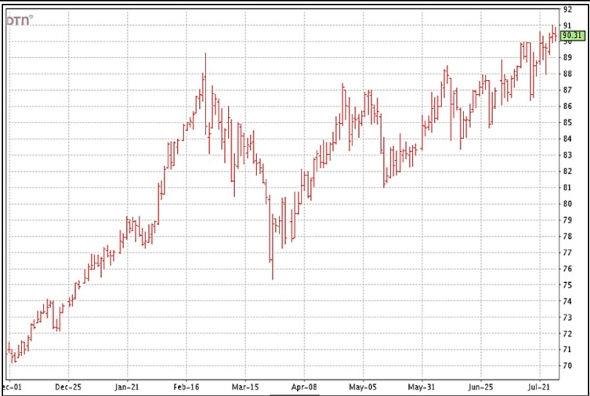By Don Shurley
A positive spin on things first. 2021 appears to be shaping up as one of those rare and blessed years where most producers will enjoy both a good crop and a good price. It doesn’t happen often.
Prices (new crop December futures) have moved to the 87 to 88 cents area 4 times since the beginning of 2021. This most recent move has now carried us to new highs at better than 90 cents. In other words, producers have had opportunities at even 85 cents or better for quite a good portion of the pre-harvest pricing period so far.

The March lows at roughly 78 cents were followed by a trend up of roughly 10 cents or about 13%. The next dip to roughly 81 cents in mid-May—if we apply the same 13% growth/rally, that would take us to roughly 91 to 92. December 21 set a new high close yesterday at 90.52 cents. Price was down slightly today, but still over 90.
The 2021 crop has been highly uncertain and to some degree, still is. But uncertainties and concerns about acres and the crop appear diminished compared to a month ago. Yet, here we are now banging the door at 90 cents. Why is that and what’s ahead?
Acres and Crop Condition
The latest crop conditions, as of July 25th, reported by USDA shows 61% of the crop in good to excellent condition. Overall condition has improved for 3 consecutive weeks and is now the highest of the season. The Texas crop is rated 53% good to excellent and only 10% very poor or poor.
The crop is, however, noticeably behind normal development in 9 of 15 states. There are still some unknowns about acres planted.
Exports
The marketing year for the 2020 crop ends on July 31. USDA projects 16.4 million bales in exports for the crop year. Their estimate was increased from 16.25 to 16.4 back in June. At the time, I remember data seemed to support this, market observers expected an increase, it was viewed as positive for the market.
Now, it seems the 16.4 number is giving cause for concern—specifically that exports may not reach 16.4 and if not, that results in a higher carry-in for 2021 on August 1.
Unfortunately, it becomes necessary to make this complicated when I wish it could be avoided. Export sales and shipments are reported in “running bales”. These bales, as you know from your own gin records, weigh roughly 500 lbs. Well, USDA data is in the equivalent amount of 480-lb bales. So, 16.4 million 480-lb “statistical bales” would be equal to about 15.74 “running bales”—assuming those bales were averaging around 500 lbs.
Will we meet USDA’s 16.4 projection? It depends… on how many “running bales” are exported and the weight of those bales. Today’s weekly export report (for the prior week ending July 22) shows accumulated shipments of 15.347 million “running bales”. This equals 15.99 million USDA “statistical bales,” if those bales average 500 lbs, and 15.83 million if they average 495 lbs. Got it?
Next week’s report will be for this week ending July 29. So, with a little over a week’s reporting remaining, we will need about 400,000 to 550,000 “running bales” to meet USDA’s projection, depending on average weight of a running bale this season. By comparison, today’s report showed 248,000 running bales shipped the prior week. If my calculations are correct and if I haven’t confused myself, we may come up around 225,000 statistical bales short of USDA’s projection.
World Demand
Optimism about World demand is undoubtedly what is fueling the drive up in price. The US crop could get bigger, but currently all attention seems focused on demand.
World demand is currently projected at 123.16 million bales for the 2021 crop year—up 4% from 2020, and 20% from 2019. And this cannot be stressed enough, USDA’s projections for the 2021 crop have increased each month. Demand has not had a hiccup.
2021 crop export sales must validate optimism in demand. One uncertainty to think about is any impact the now increasing new COVID risks might have on economic activity around the World.
Source : ufl.edu